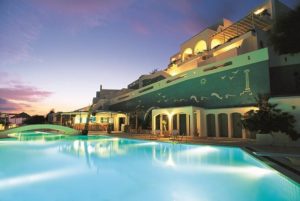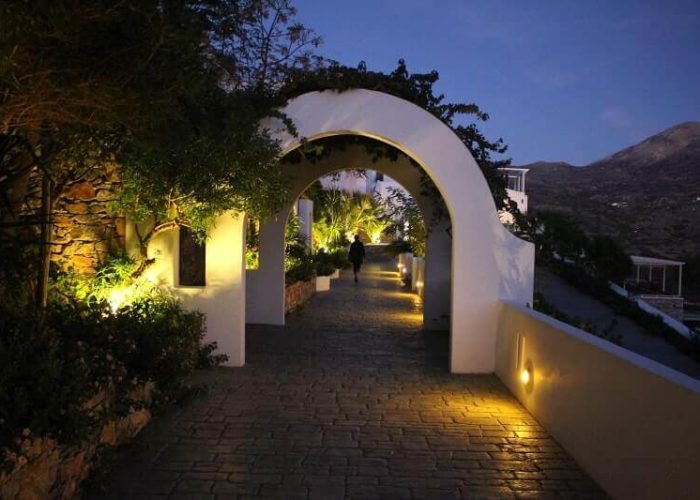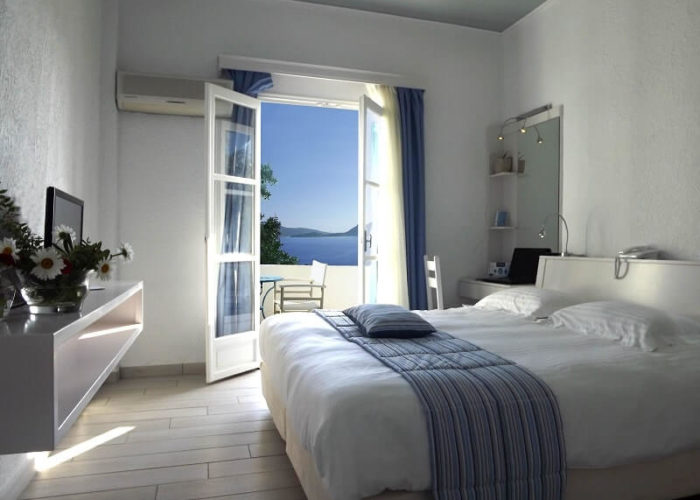The story of Amorgos Island is a tale of beauty — “omorfos” in Greek. Folklore has it that it was once known, among the Cyclades, as the island where only beautiful women resided. Always alluring, it remains largely undiscovered even today.

With its raw and organic natural beauty, Amorgos is breathtaking. On a bright day, it is within viewing distance of Naxos, Santorini and Ios, on the southern side of the Cyclades. The island’s traditional architecture will send you back 100 years. Its pace of life remains slow, as the charming locals see no reason to compete for tourism dollars with their lofty neighbors in Santorini or Naxos. Amorgos’ beauty inspired filmmaker Luc Besson to shoot scenes for the movie “The Big Blue” on the beach of Agia Anna. He chose the pebbly beach for its cobalt hues and crystalline waters.
While there are two primary beaches near the harbors of Aegialis and Katapola, this is an island that cries for exploration. Visitors find many hidden coves and shores as they trek around the island. Many times you will have a whole beach to yourself. The most recognized site on Amorgos Island is the jaw-dropping, 1,000-year-old Monastery of Hozoviotissa. The sacred place of worship is embedded on the slope of a rock-face mountain and descends eight floors, with breathtaking views leading out to the nearby deep blue Aegean Sea.
Visitors should arrive with hiking boots. To properly explore the island, one must plan long days on the vast trail system. You can walk short distances or spend hours exploring its diverse paths and abandoned villages, beneath velvety clouds that perch atop jagged mountain peaks, or sunlight that splashing the horizon. The ancient capital of Chora is a step back in time.
A Love Story

The island’s matriarch, and its most outspoken tourism advocate, is Irene Giannakopoulos, owner of the family-run Aegialis Hotel & Spa. The charismatic Giannakopoulos has been a skilled hospitality expert since her early childhood, when she helped her parents run the family business, a small hotel in the village of Lakki. Having learned English by the age of 10, the “first lady of Amorgos” was the leading pioneer in tourism bringing sojourners to the little-visited island. Irene Giannakopoulos’s life story would make for an enchanting Hollywood love story. She was 14 years old when she met her husband-to-be, Nikitas, 10 years her senior. Little did she know that the handsome Adonis would become the love of her life.
The young man had been beckoned to the New World by promises of prosperity, however. He left for America, from where he corresponded by mail with the teen-age stunner. After a year of long-distance correspondence, the young beau wrote to her parents, whom he had never met, asking to marry the girl. They agreed, with one condition: She must first complete high school. It was at the church in Athens where Nikitas officially met the family for the first time. Soon after, the couple moved to America and settled in New Jersey. As Irene had learned English at a young age, her transition to a new life was relatively swift and painless. They had arrived with little savings. They invested in a furniture store, and turned their earnings into a grocery and next-door pizzeria.
But they missed their Greek homeland. The couple decided to return to Amorgos to build a house and spend summers on the island, tending to Irene’s father’s small hotel. “Working in the family business brought out my love for housing guests on our most beautiful island paradise,” Irene said.
Building a Hotel

The genesis of the Aegialis Hotel & Spa was a bit of grit and luck. One day, the visionary couple found a barren hillside with a breathtaking view overlooking the port of Aegialis and the town of Ormos. Taking a loan with a skyrocketing 36% interest rate, they bought the property in 1989. “Everyone said this was not a realistic dream and we would lose this land,” Irene recalled. But perseverance paid off, and the Giannakopoulos’ luxury boutique hotel was completed in 1992.
Even before construction was complete, travelers were lining up to stay at the new resort hotel. Work on the steep hillside was challenging, as laborers from all over Greece contributed their skills. Irene spent extended time in Athens to clear paperwork and red tape thrown up by the Greek bureaucracy, while Nikitas stayed on Amorgos, keeping up with the daily construction.
Indeed, Amorgos didn’t even have electricity when the Giannakopouloses began work. “The island was completely unknown when we started to build,” Irene said. “Amorgos was not on the travelers’ path in the same way as Santorini or Mykonos. There would have been no reason to promote the hotel if Amorgos, as a destination, was not first promoted as a viable tourist island.”

That was when Irene, the tourism booster, took over. Soon after the hotel opened, she invited Greek journalists to Amorgos for a stay at Aegialis. In doing so, she involved local ferries as a partner in the island’s growing success. It was a win-win situation, she said — “a victory for the shipping companies.” Soon, the international press took notice. The Aegialis Hotel & Spa became synonymous with Amorgos island.
“We always believed in the guest coming first,” Irene said. “Small touches, such as serving coffee in the guests’ rooms, were an innovative idea at the time.” Her youthful lessons in hospitality, when she traveled from her parents’ hotel to greet guests coming off the ferries from Piraeus, were used well in training the team at Aegialis Hotel & Spa.
The hotel is constantly looking to improve the guest experience and work on broader projects, like promoting hiking and yoga on the island, said sales manager Semeli Drymonitis. “Much more than just giving keys to people, we provide a local experience,” she said. “We care about our guests who, if they have an enjoyable experience, will tell their friends.”
Hotel Facts

The hotel boasts 55 newly renovated, wheelchair-accessible rooms. A sustainable garden grows tomatoes, peppers, zucchini, cauliflower, pumpkin, lettuce, onions, cucumbers and assorted Greek herbs, all of them made good use of in the inn’s pizza oven.
Its highlight is the stunning Lalon Idor Spa, whose name means “taking water.” Opened seven years ago, it was inspired by ancient Greece’s legendary Oracle. “They used to call a spa a Jacuzzi,” Irene recalled, shaking her head. “In all of the neighboring Cyclades, there was no comparison to what we were trying to accomplish.” Lalon Idor includes outdoor and indoor saltwater pools, a sauna, a hammam (or Turkish bath) and a gym. Treatment rooms offer numerous therapies, including aromatherapy massages with essential rosemary, citron, geranium and olive oils.
More recently, the Aegialis has added two rooms specifically for yoga enthusiasts. And Irene has teamed with other local epicureans to create a schedule of wine tastings and cooking demonstrations with a uniquely Amorgonian spin.
Ecotourism

After going on an eight-hour trekking excursion with Greek hiking expert, Fivos Tsaravopoulos, who runs the website Paths of Greece, is a trail expert who leads eight-hour trekking excursions all over the island of Amorgos. “The hiking is nothing short of breathtaking,” he says. “The island is impressive. The heights that you climb are up to 800 meters (2600 feet) straight from the sea. The originality of the trails leads you to places you cannot explore by car.
“Strolling through the ancient villages is like traveling back in time. A meeting with the diversity of elements, the earth, the sea, sheer cliffs, the wind, and the changing of the weather is perhaps best viewed from Amorgos Island, from the highest point to the lowland beaches.”
For me, wanderlust is kicking in and I’m already plotting my return. I dream of getting off the beaten path, of sun-drenched summer days, relishng long hikes on the mountainous island right up until another eye-popping burnt-orange sunset. The slower pace of life, its quaint abandoned villages with leftover chapels, the gentle and playful donkeys, its otherworldly monastery built into the side of a mountain. I will return to Amorgos.
Getting There
The island is connected with Athens’ port of Piraeus, on the Greek mainland. Ferries link the island to Crete, Naxos, Syros, Paros, Koufonissi, Schinoussa, Donoussa and Astypalea. Boats arrive at Amorgos’ ports of Katapola and Aegiali, alternating even and odd days. From Piraeus, the voyage takes 7½ hours and costs around 30 euros (economy class, one way) or 43 euros (business class, recommended!). As Amorgos is the last stop, you will arrive at 2 a.m. Arrange for your hotel to pick you up, or plan on a taxi service ahead of time. Departures are at 6 a.m.
Book this hotel: Booking.com













